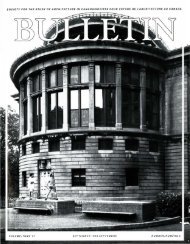CANADA - SEXTONdigital
CANADA - SEXTONdigital
CANADA - SEXTONdigital
Create successful ePaper yourself
Turn your PDF publications into a flip-book with our unique Google optimized e-Paper software.
J ULIAN SMITH > ESSAY I ESSAI<br />
FIG . 9. BARCELONA PAVILION, MIES VANDER ROHE, RECONSTRUCTION.! PIERRE DO Pt!EY 1!1117. FIG . 10. BARCELONA PAVI LION, MIES VANDER ROHE, RECONSTRUCTION. ! PIERRE DO PREY 1!187.<br />
intact (fig. 11). Frank Lloyd Wright's Fall -<br />
ing Water has been restored with coat-<br />
ings on the concrete that are not the<br />
same as he used but recreate the intend-<br />
ed formal qualities of the composition.<br />
And in each case, the reconstruction is<br />
designed to last indefinitely; to ignore<br />
the effects of aging by using the latest<br />
available technology. The recent restoration<br />
of Vimy is designed to last for a<br />
hundred years. This hubris is not so different<br />
from that of the original creators,<br />
approximation of the original. A few<br />
centuries from now, one can imagine<br />
Percy Bysshe Shelley's "traveller from an<br />
antique land" reporting about Vi my:<br />
have convinced us that the physical reality<br />
is the only thing we are working with. We<br />
direct all our energies at physical repair.<br />
We have not explored adequately the<br />
possibility for representing these ideas<br />
... on the pedestal. these words appear: in virtual forms; forms that can stimulate<br />
-My name is Ozymandias. King of Kings,<br />
Look on my Works. ye M ighty. and despair!"<br />
Nothing beside remains. Round the decay<br />
Of that colossal Wreck. boundless and bare<br />
The lone and level sands stretch far away.<br />
the imagination and keep the ideal alive<br />
even as the embodiment decays.<br />
For the sake of comparison, consider<br />
the Parthenon in Athens. This monument<br />
had become a ruin; decay had<br />
and involves the restorers in the same In the case of the Vimy Memorial, decay been allowed to run its course for cen -<br />
modernist conceits. is also of broader philosophical interest. turies. The monument occupied a land-<br />
There was, in fact, one other conservation<br />
option for Vimy. It was raised early on<br />
in the process, but had been ruled out a<br />
priori in the project brief and was never<br />
seriously discussed . The option was to<br />
allow the monument to decay; in other<br />
words, the do nothing approach. According<br />
to this scenario, all the various repair<br />
insertions would have been removed, and<br />
the honesty of the decay process revealed<br />
for all the world to see. The surviving original<br />
material, damaged or not, would<br />
have been stabilized but not replaced .<br />
This approach would have led to a more<br />
and more ruinous state, over time, but<br />
at least the integrity of Allward's vision<br />
would not have been compromised by<br />
half-hearted attempts to maintain an<br />
Our monuments, however designed and<br />
conceived, are doomed to decay with<br />
time. Our memories also decay, and in<br />
some ways the healing process of the<br />
reforestation at Vimy and elsewhere is<br />
about a deliberate decaying of memory,<br />
about a letting go of the terror embedded<br />
in the war landscape.<br />
In this approach, the formal purity of the<br />
original conception would be recreated<br />
in the imagination of the visitor. And this<br />
brings back the question of representation.<br />
One of the reasons decay does not<br />
seem to be an acceptable option when<br />
dealing w ith modernism is that the<br />
physical object seems the only testimony<br />
to the ideas it embodies. The use of the<br />
photograph and the measured drawing<br />
scape of ruins, part of an assemblage of<br />
fragments of classical civilization. Then,<br />
in the late eighteenth century, Stuart<br />
and Revett produced an extraordinary<br />
book, The Antiquities of Athens, which<br />
provided two powerful and contrasting<br />
views of the Parthenon: one a perspective<br />
showing a romantic vision of the<br />
overgrown site with its seductive hints<br />
at former greatness (fig. 12); the other a<br />
magnificent elevation of a restored Parthenon<br />
in all its pristine purity (fig. 13).<br />
Both are copper plate etchings, but the<br />
approach in each was very different - the<br />
second is not placed within a landscape<br />
setting, but simply engraved with meticulous<br />
care as a free-standing image.<br />
The absolute symmetry of the forms was<br />
reflected in the design of the book itself,<br />
54<br />
JSSAC I JStAC 33 > N• 1 > 2008
















